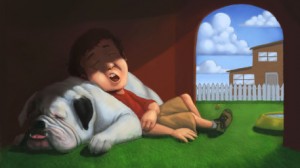All highlighted key-words (in blue) are hyperlinked to appropriate Youtube & other web-pages for instant transport to an imaginative, nostalgic ‘re-viewing’ in your minds ~ to add to the relish of this song & theme review of “Dosti” below:
No, the allusion here is not to Sholay , but to the good old Bollywood classic Dosti , a recent re-watch (on YouTube) of immortal Rafi-rendered songs of which brought back a poignancy cavalcade from the sweet, smouldering saga of love, friendship, estrangement, heartache & reunion that this Bollywood jewel of yesteryear was.
It happens to be one of the earliest watched movies of my life, in mid-sixties, when I was barely 6 or 7. And what an endearing treasure of melodious songs (composed by Laxmi-Pyare) replete with impassioned lyrics (of Majrooh Sultanpuri) on the meaning of friendship & love this lovely flick from Tarachand Barjatya stable has that it does not fail to move heart & soul even today.
The first song Jaane Walon Zara , which speaks of the eternal “such-is“ness of human condition, is a pointer to one & all of the conditioned blindness to our common roots of consciousness (through the allegorical blind, street-beggar protagonist in Sudhir Kumar).
It starts off with a short, sweet ‘aalap‘ by maestro Rafi and goes on to issue a gentle exhortation crafted in the lyrics:
“Jaane walon zara murh ke dekho idhar,
ek insaan hoon main tumhaari tarah”.
As Sudhir Kumar proceeds to warble (in Rafi’s divine voice)
“Jisne sab ko racha apne hi roop se,
uski pehchaan hoon mein tumhaari tarah“
and following the succeeding rasomalai-esque mouth organ support from Sushil Kumar (the other lead protagonist, lame of legs, comprising the Dosti duo) continues with
“is anokhe jagat ki mein taqdeer hoon,
mein vidhata ke haathon ki tasveer hoon;
is jahaan ke liye, dharti maan ke liye,
Shiv ka vardaan hoon, mein tumhari tarah“,
The camera hovers on numerous innocent kids in the audience and you are forced to wonder if it is not a pair of angels who have chosen to walk incognito on earth as the blind- lame Dosti pair hoping to bring reminders to us of love, friendship & joy of companionship inherent in our true nature.
It gets even better from hereon as
“man ke andar chipaye milan ki lagan,
apne Suraj se hoon ek bichdi kiran,
phir raha hoon bhatakta
mein yahaan se wahaan,
aur pareshaan hoon
mein tumhari tarah“ gives voice to the eternal human search for meaning in life that seems to strike instant chord with the watching, nodding audience- both old & young- in the song clip so beautifully pictured way back in the sixties.
“Mere paas aao chhodo ye saara bharam,
jo mera dukh wahi hai tumhara bhi gham;
dekhta hoon tumhein, jaanta hoon tumhein,
laakh anjaan hoon ,main tumhari tarah“
becomes the piece de resistance, as you view an adoring, wise-old-divine-looking man, emerging from the audience seeming intent to bless the singing angel for a message well conveyed.
The title song of the movie, Meri Dosti Mera Pyaar, celebrates the quintessential human requirement of friendship & platonic love enunciated in
“koi jab raah na paye,
mere sang aye,
ke pag pag deep jalaye;
meri dosti mera pyaar!”
Here the blind protagonist, singing paeans of his dosti & love for his dispossessed sister endeavours to inform the world:
“dono ke hain roop hazar,
par meri sune jo sansar;
dosti hai bhai
to behna hai pyaar“
and continues to extol the emotion of love & camaraderie with
“pyaar ka hai pyaar hi naam,
kahin Meera, kahin Ghanshyam;
dosti ka yaaron nahin koi dhaam.”
In Raahi Manwa Dukh Ki Chinta the philosophy of equivocation in both joy & sorrow finds an enchanting expression as
“door hai manzil door sahi,
pyaar hamara kya kam hai,
pag mein kaante laakh sahi,
par yeh sahara kya kam hai:
hamrah mera koi apna to hai.”
The mellifluous mouth organ accompaniment by Sushil Kumar in this song is simply electric to the ears!
The haunting melody Chahoonga Main Tujhe Saanjh Savere is one of the great gems by Rafi where he brilliantly succeeds in mutating, as only he can through his perfectly pitched euphonic voice, the melancholy of estrangement into divinely inspired acceptance of oneness despite distance.
“Dard bhi tu,
chain bhi tu,
daras bhi tu,
rain bhi tu;
mitwa mere yaar,
tujhko baar baar awaaz main na doonga“
so meaningfully & resonantly conveys the pathos of a heart torn asunder by the pain of separation, yet determined to continue blessing the love of its life. The song fetched a Filmfare award apiece to both maestros Majrooh & Rafi for best lyrics and playback.
The alchemy is complete with Mera To Jo Bhi Kadam Hai which takes the theme of the previous number further forward enabling you to perceive the pinnacle of pathos getting transformed into acquiescence to what is in an inimitable performance by the melody king Rafi crooning
“khara hai dard ka rishta to fir judai kya,
juda to hote hain woh khot jinki chhah mein ho“
and
“chhupa hua sa mujhi mein hai tu kahin ai dost,
meri hansi mein nahin hai to meri aah me hai“
This superbly soulful rendition has in it what it takes to move you to tears.
Tears provisioning for the movie buffs here, however, is not in their sad variants alone. The scintillating Lata number Gudiya Hamse Roothi Rahogi , featuring a doting Leela Mishra attempting (and succeeding) to woo back an estranged Baby (Daisy) Irani with a sundry collection of dolls & mannequins while crooning
“dekho ji kiran si lehar aayi,
aayi re aayi re hansi aayi”
is a veritable tears-to-joy composition.
All in all, the musical score from this box office hit of 1964 provides a great trip down the nostalgia lane and is the kind of fare no Bollywood yesteryear’s aficionados can ever think of parting ‘dosti ‘ with!
Show Your Love and Appreciation:



